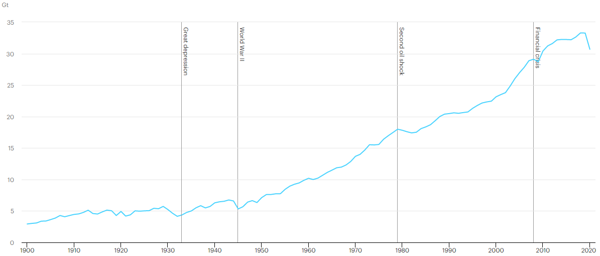How COVID-19 affects the climate?
The COVID-19 brought us severe restrictions and production in many factories was put on hold, the travelling was stopped and general energy consumption was reduced. The actual reduction of energy consumption depends on the lockdown of the countries. The complete national lockdown in India reduced energy consumption almost by 30% but the same situation in Europe has been gradual process and the consumption has been falling by an average of 17%. This of course affects the climate. For example, many of the factories in China stopped working in February and the emissions temporarily fell by 25%. Global CO2 emissions were over 5% lower in Q1 2020 than in Q1 last year. Furthermore, the air pollution level has dropped during the lockdown period in India and for the first time after 30 years the Himalaya mountains are visible again from hundred kilometers away. This is a beautiful view but it also has an important positive effect on human health.
According to the International Energy Agency (IEA), global CO2 emissions are expected to decline by 8% (almost 2.6 gigatonnes (Gt)) to the level of 10 years ago. This would be the lowest level since 2010. Such a reduction would be the largest ever, six times larger than the previous record reduction of 0.4 Gt in 2009 due to the financial crisis and twice as large as the combined total of all previous reductions since the end of World War II. The following figure shows how the carbon content in the atmosphere has risen since 1900.
IEA, Global energy-related CO2 emissions, 1900-2020, IEA, Paris
https://www.iea.org/data-and-statistics/charts/global-energy-related-co2-emissions-1900-2020
However,
some scientists are pessimistic and believe the emissions rate will rise
rapidly to previous level after the crisis is over because of the global
economy’s boosting investments. During the previous global financial crisis a
little more than a decade ago, CO2 emissions recovered in only
less than a year. Every country has to make the best decisions based on lessons
learned during the COVID-19 pandemic. Now we have the proof that we can affect
the climate, and we should learn from it for greener environment and cleaner
air. All the countries should cooperate and make the decisions together. Every
little action matters. Why not to continue with the video conferences as we had
to do during the lockdown period? This would reduce the severe airplane
emissions.
Sources:
IEA (2020), Global Energy Review 2020, IEA, Paris
https://www.iea.org/reports/global-energy-review-2020
Research in Estonia. 03.04.2020. What is coronavirus doing to our planet?
https://researchinestonia.eu/2020/04/03/what-is-coronavirus-doing-to-our-planet/
Daily Mail. 08.04.2020. The Himalayas are visible in parts of India 125 miles away for the first time in 30 years after coronavirus saw pollution levels drop across the country
 lines
lines 